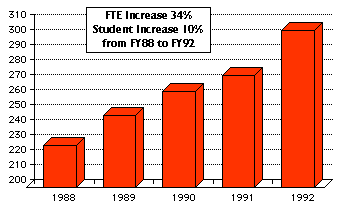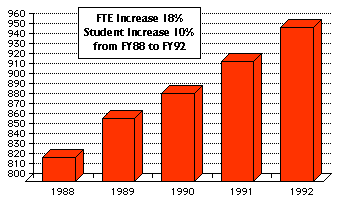
Dave Lewis
Budget Director
Office of the Governor
In my opinion, the report of the consultant does not alleviate our concern with regard to the growth in administrative costs since 1988, or the use of current "peer" data. Nor do the consultants in their final report make any serious attempt to address the potential savings through restructuring the higher education enterprise.
The public, as well as the subcommittee, should be reminded that the report, including the scope of the study, was instituted by the Commissioner of Higher Education (CHE) and the campus presidents. The $85,000 cost of the 60-80 day study was paid for with campus funds. It should come as no surprise that we would take issue with many of the findings or, more importantly, the omissions of the report. I should also emphasize that the consultants did not attempt to interview me or anyone on my staff with regard to their report, but limited their report to the opinions of only the higher education officials.
While no one was expecting a "gold mine of administrative savings" as a result of the report, we would take issue with the consultant's report that administration has not grown disproportionately in recent years. The attached graph [figure 1] shows the FTE employees in the Institutional Support Program (i.e., administration) has grown 34% (307 FTE in FY92 compared to 229 FTE in FY88) since FY88, while enrollment has only increased 10%.
Figure 1

The FTE employees for all of the programs of support [figure 2] increased from 823 in FY88 to 972 in FY92 or 18% as compared to enrollment increases of 10% for the same period.
Figure 2

While we are addressing the final report today, I found it interesting to compare the final report, dated March 1, with the preliminary draft, dated February 10. Many of the consultant's concerns, regarding the CHE's reliance on peer data comparisons as well as the need for restructuring and consolidating units of the university system, that were contained in the February 10 report are missing from the final report issued three weeks later. The transformation from draft report to final report contains some major re-editing.
For instance, the preliminary report had this to say about comparisons: "Based on these 1987 data, the staffing ratios of the Montana schools are much closer to the peers than the dollar comparisons in Exhibits 2-1 through 2-5. We believe that this indicates that the exclusion of designated funds for the Montana units with imperfect information on the peers tends to understate the relative position of the Montana schools."
Our analysis indicates that the following observations are appropriate:
A state which wishes to use peers as a bench mark should be prepared to spend the time and money to ensure that the data are consistent and accurate. Decisions should NOT be made on the current base of information!
At least some of the peers should be revisited. The use of Eastern Washington [University] for Eastern Montana [College] is questionable as is the use of the highly specialized Oregon Institute of Technology for Northern [Montana College]. In addition, the use of the same set of peers for UM and MSU is questionable.
Comparisons should either be based on total educational and general expenditures or should consistently define and exclude designated funds.
Based on our review, it is clear that until improvements in the process are made, peer analysis should be used only as a general indicator and not as a "determining factor."
The final report was modified with regard to the comparisons and stated the following:
"First, the peer data provide an insight into the relative status of administrative expenses in the MUS compared to institutions which have been deemed to be similar. Second, the use of peer comparisons figures heavily in policies of the MUS and a review of the process provides information on how well the Office of the Commissioner is able to make accurate comparisons. The purpose of our review was not to evaluate whether the peer institutions are appropriate (although in our opinion such a review would be in order) nor was it to conduct a new analysis." [emphasis supplied]
Based on data supplied by the CHE, the final report implied that the inconsistencies in accounting practices of the peers and the Montana University System with regard to designated funds are immaterial when compared to total budgets. We disagree.
Computer fees, equipment fees, and other designated fees that should be included in the calculation of cost per student when making peer comparisons total between $5-6 million over the biennium. The proper base to use in determining "materiality" is not the total budget ($144.3 million). Materiality should be determined on the basis of total student fees ($38 million per year). The amount of fees in question would amount to 6.6% to 7.9% of the fees collected in FY92. If the CHE claims that $5 million over the biennium is not a material amount, then why is a proposed $24 million cut over the biennium a catastrophic reduction?
Since the title of the consultant's report incorporates the term "studies of administrative structure," we were hoping the final report would incorporate some specific structural alternatives.
The February 10 draft spoke to the possible advantages of restructing the administration of the university system. For instance, page 31 of the first draft has a chart of a revised structure that was similar to what the governor has asked the regents to consider in his revised budget. The final report provided only a watered-down statement endorsing the CHE's effort to present a plan by October 1, 1993. Both the draft and the final report stated, however, that "nearly every senior administrator interviewed indicated that the state of Montana did not need six four-year institutions ...."
If, for instance, Eastern Montana College (EMC) were merged with the University of Montana (UM), Eastern could offer programs and degrees under the authorized degree and curriculum umbrella of the University of Montana. Both campuses could operate under a single catalog, simplifying or eliminating the problem of transferability and duplication. EMC's academic departments could be integrated into UM's academic structure, reducing the need for academic administration. For instance, the dean of the UM business school could establish the curriculum and course offerings at both locations. The savings could be reinvested to maintain and enhance the quality of the faculty. UM could provide much of the administrative support just as Montana State University (MSU) now does for the Agricultural Experiment stations and Extension Services staff. This type of consolidation and reorganization is a valid way to free up money from the current budgets to improve instruction.
The consultant's report did not attempt to address our earlier concern that out of $8.5 million added to HB2's original appropriation, only $921,772 found its way into the instruction program. Over $5.7 million went into support. These amounts came straight off the records of the Statewide Budget and Accounting System.
The consultant's report made some interesting recommendations regarding contract research funds. Noting that the campuses are allowed to retain 100% of indirect costs generated, the report points out that the state has to cover administrative support expense of carrying out research from the general fund. The report suggests that the ratio beyond a base year should probably be shared at a 50-50 ratio.
Over $6 million in indirect cost funds are collected over the biennium. The current ending fund balances (excluding compensated absences) are currently over $1.5 million. The legislature may want to recoup part of the general fund subsidy for administrative research overhead by appropriating a portion of the indirect cost reserves.